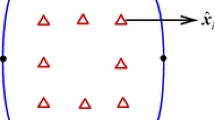Abstract
The range of applications of Boundary Element Methods (BEM) is restricted to cases where the fundamental solution is known. An approach recently developed by the author via the Fourier transform generalizes the BEM to the so-called Fourier BEM (Fourier BEM—generalization of boundary element methods by Fourier Transform. Springer, Berlin Heidelberg New York, 2002). There, new boundary integral equations (BIE) are formulated, which consist only of Fourier transformed terms and lead to equivalent matrices as in the standard approach. They make use of only the Fourier transform of the fundamental solution, which is much easier to obtain (available for all cases as long as the differential operator is linear and has constant coefficients). No inverse transform and no fundamental solution in the original space are required. Here, the theory is summarized and an example of anisotropic elasticity is given to motivate the discussion of singularities, which is the topic of this paper. It is shown, that all types of singularities (weak, strong, and hyper) occur as in the standard approach and that they require a new treatment because they are originating from newly developed integral equations. The main result is that the non-regular parts of the strong and hyper singular integrals cancel if ordered correctly.
Similar content being viewed by others

References
Bonnet M (1999) Boundary integral equation methods for solids and Fluids. Wiley, New York
Duddeck FME (2001) Fourier BEM—or what to do if no fundamental solution is available?. Meccanica 36:437–448
Duddeck FME (2002) Fourier BEM—generalization of boundary element methods by Fourier transform. Springer, Berlin Heidelberg NewYork
Duddeck FME, Geisenhofer M (2002) A generalization of boundary element methods by Fourier transform. Comput Mech 28:303–310
Duddeck FME (2006) An alternative approach to boundary element methods via the Fourier transform. Comput Model Eng & Sci 16(1):1–13
Gray LJ, Paulino GH (1997) Symmetric Galerkin boundary integral fracture analysis for plane orthotropic elasticity. Int J Numer Meth Eng 29:1135–1158
Head AK (1979) The Galois unsolvability of the sextic equation of anisotropic elasticity. J Elast 9:9–20
Hörmander L (1990) The analysis of linear partial differential operators I, 2nd ed. Springer, Berlin Heidelberg New York
Schwartz L (1950–51) Theorie des distributions I, II. Hermann and Cie, Paris
Author information
Authors and Affiliations
Corresponding author
Rights and permissions
About this article
Cite this article
Duddeck, F.M.E. Hyper and strong singularities of the Fourier BEM. Comput Mech 41, 749–757 (2008). https://doi.org/10.1007/s00466-006-0147-5
Received:
Accepted:
Published:
Issue Date:
DOI: https://doi.org/10.1007/s00466-006-0147-5



